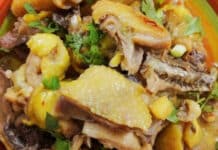Air and blood are two of the most vital components in the human body. Blood not just nourishes our vital organs, but also provides essential nutrients to our skin, hair, tendons, and bones, ensuring our body functions optimally.
Anemia, or iron deficiency, occurs when the body lacks sufficient red blood cells or hemoglobin, leading to a reduced ability to carry oxygen to the body’s tissues. This can result in a range of unpleasant symptoms, including fatigue, dizziness, forgetfulness, insomnia, and menstrual irregularities in women. The paragraph emphasizes the importance of addressing anemia and provides insights into potential underlying causes, particularly in the elderly.
A balanced diet is crucial to combating anemia. However, certain demographics, such as the elderly, may require additional considerations. For instance, older adults may follow inappropriate diets, such as strict vegetarianism, which can lead to insufficient protein and fat intake. Additionally, dental issues, diminished sense of taste, and digestive problems can hinder their ability to absorb nutrients effectively. This can result in a lack of essential raw materials needed for blood production, leading to a decreased count of red blood cells and hemoglobin.
Moreover, polypharmacy, or the use of multiple medications, is common among the elderly, especially those managing chronic conditions like hypertension, diabetes, and coronary artery disease. Certain drugs, such as anti-platelet medications, can cause gastrointestinal bleeding and, consequently, anemia. Furthermore, some medications may suppress bone marrow function, further contributing to anemia.
Anemia can also be a symptom of various infections, arthritis, kidney disease, and, importantly, cancer. Malignant tumors in the digestive system, including stomach, colorectal, liver, and esophageal cancers, may present with anemia as an initial symptom, even without noticeable lumps or other obvious signs. These cancers impair the absorption of blood-forming nutrients, and if left untreated, can lead to prolonged anemia.
It is important to note that not all tumors are malignant, and determining malignancy involves considering two key factors:
– Prolonged, unexplained anemia: When anemia persists without a clear cause, or when mild anemia persists over a long period, further investigation is warranted.
– Anemia accompanied by other symptoms: For example, anemia caused by esophageal cancer may be accompanied by difficulty swallowing and vomiting after eating. Anemia resulting from colorectal cancer may present with blood in the stool and altered bowel habits, while stomach cancer-induced anemia is often coupled with abdominal discomfort, nausea, and vomiting.
Addressing anemia involves more than just consuming red dates or other iron-rich foods. In fact, red dates may not be the best option for iron supplementation. According to the “Food Composition Table,” the iron content in red dates is approximately 2.1 mg/100g, which is only a fraction of the iron found in dried cabbage (approximately 12.6 mg/100g). Additionally, the body’s absorption rate for plant-based iron is lower, ranging from 1% to 5%, compared to the 20% to 30% absorption rate of iron from meat sources.
To effectively combat anemia, it is recommended to include a variety of iron-rich foods in your diet, such as:
– Red meat: Beef, pork, and lamb are excellent sources of heme iron. A 100-gram serving of beef tenderloin provides 3.3 mg of iron, while the same amount of pork and lamb contain 3 mg and 2.7 mg of iron, respectively. However, it is important to consume these meats in moderation, with a suggested intake of 40-75 grams per day.
– Animal liver: Pork liver contains 22.6 mg of iron per 100 grams, while chicken and goose liver offer 12 mg and 7.8 mg of iron per 100 grams, respectively. However, due to their high-fat content, it is advisable to consume liver in moderation, with a suggested serving of around 20 grams.
– Animal blood: Animal blood, such as duck blood (30.5 mg of iron per 100 grams), chicken blood (25 mg of iron per 100 grams), and pig blood (8.7 mg of iron per 100 grams), is another rich source of iron.
– Green leafy vegetables and fruits: Some vegetables, like green cabbage, are particularly iron-rich, containing around 17.2 mg of iron per 100 grams. Black mushrooms and pine mushrooms are also excellent sources of iron. Additionally, fresh fruits and vegetables are packed with vitamin C and folic acid, which enhance iron metabolism and absorption.
In conclusion, addressing anemia involves more than just consuming iron-rich foods. It is imperative to identify the specific cause and implement appropriate treatment measures. Preventing anemia requires a balanced diet that ensures the body receives all the necessary nutrients.

Common causes of anemia in the elderly:
Malnutrition and physical decline
Older adults sometimes follow inappropriate diets, such as strict vegetarianism, which may result in insufficient protein and fat intake. Additionally, dental issues, diminished sense of taste, and digestive problems can hinder their ability to absorb nutrients, leading to a lack of essential raw materials for blood production.
Medication side effects
Polypharmacy is common among the elderly, especially those managing chronic conditions. Certain medications can cause gastrointestinal bleeding, leading to anemia. Additionally, some drugs may suppress bone marrow function, further contributing to anemia.































